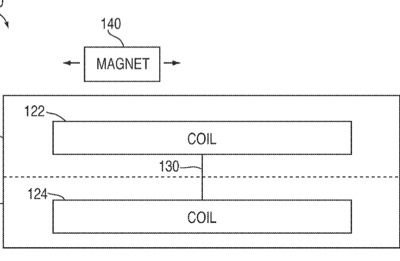An Apple patent (number 20110057629) for harnessing power through electromagnetic induction has appeared at the US Patent & Trademark Office.
Systems for harnessing power through electromagnetic induction utilizing printed coils are provided. A system can include one or more moveable magnets adjacent to printed coils on a circuit. For example, a system can include one or more magnets that are operative to move alongside a circuit board that includes printed coils.
The one or more magnets may move, for example, when a user shakes the system or when the user walks or runs while holding the device. The movement of the one or more magnets may create an electromotive force (e.g., a voltage) across the printed coils, and this force may be used to generate electric power. The inventors are Gloria Lin, Pareet, Michael Rosenblatt, Taido Nakajima and Bruno Germansderfer.
Here’s Apple’s background and summary of the invention: “Traditional systems for harnessing power through electromagnetic induction involve wire coils, a magnet, and relative movement between the two. To achieve meaningful output power, a traditional system typically includes thick coils of wire that add to the system’s overall size. Moreover, the wire coils and magnet of a traditional system are often housed in an inefficient manner that further adds to the system’s overall size.
“Systems for harnessing power through electromagnetic induction utilizing printed coils are provided. A system can include one or more moveable magnets adjacent to printed coils on a circuit. For example, a system can include one or more magnets that are operative to move alongside a circuit board that includes printed coils. The one or more magnets may move, for example, when a user shakes the system or when the user walks or runs while holding the device. The movement of the one or more magnets may create an electromotive force (e.g., a voltage) across the printed coils, and this force may be used to generate electric power.
“Printed coils can be formed using any suitable technique for printing circuit boards. For example, printed coils can be formed by depositing copper on a substrate to form traces in the shape of coils or selectively etching copper from a substrate to form traces in the shape of coils. In some embodiments, a circuit board may include multiple layers and printed coils can be formed on two or more of the layers. In such embodiments, the coils may be electrically coupled using vias to create a coil array. In some embodiments, multiple circuit boards with printed coils may form stacks of circuit boards that are electrically coupled together to form a coil array.
“One or more moveable magnets may be used to harness power through electromagnetic induction. For example, a system may include a single magnet adjacent to one side of a coil array. In another example, a system may include a first magnet adjacent to a side of a coil array and a second magnet adjacent to an opposite side of the coil array. The two magnets may move freely alongside the printed coils or they may be coupled together so that they move in unison.”
— Dennis Sellers


